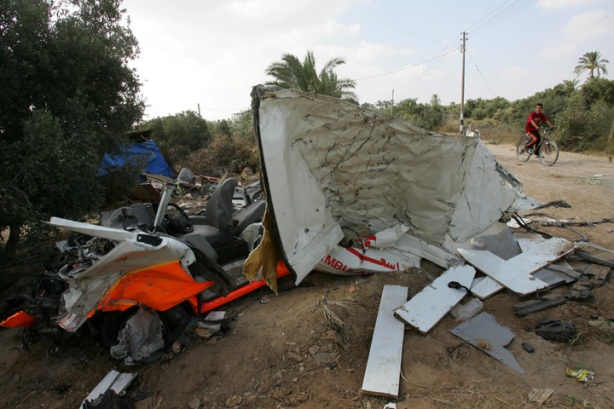
Rules on who can be targeted and how in warfare derive from customary law and international treaties and regulations
Afua Hirsch, legal affairs correspondent
guardian.co.uk, Tuesday 24 March 2009 14.00 GMT
Article history
The use of drones, targeting of medical staff and facilities and use of human shields raise numerous issues of international humanitarian law, the body of law concerned with the treatment of individuals during international armed conflict.
Some of these are allegations of war crimes – defined as grave breaches of international humanitarian law, including wilful killing, wanton destruction of property and attacking civilians. Some of these rules derive from customary law – generally recognised practices binding on all states. Others are contained in international treaties including the fourth Geneva convention of 1949, the first additional protocol to the Geneva convention of 1977, and the Hague regulations of 1907 that regulate means and methods of warfare.
Although Israel is only party to the fourth Geneva convention, and Palestine has not been party to any international agreements due to its lack of recognised sovereignty, many of these principles have also become recognised as general principles of customary law, extending to all international armed conflicts.
Drones
Lawyers say that the use of drones in the Gaza Strip caused widespread destruction in violation of the principles of necessity, distinction and proportionality.
“Necessity” requires a state fighting an armed conflict to use only the degree and kind of force required to achieve the legitimate purpose of the conflict. This is presumed to be the submission of the enemy at the earliest possible moment, with minimum expenditure of life and resources.
Causing death and the destruction of property is only lawful where it complies with necessity and where there is a reasonable connection between the actions and the military objectives pursued. This principle is often closely linked with proportionality – the requirement that “the losses resulting from a military action should not be excessive in relation to the expected military advantage”. Under the principle of proportionality, when conducting hostilities in an urban area, the combatants have an increased duty of diligence to spare civilians from the effects of hostilities.
Civilians and civilian buildings and infrastructure
In addition, Israel is accused of failing to distinguish between civilians and combatants, and also between civilian buildings and infrastructure, and legitimate military targets.
A civilian is defined under international humanitarian law as somebody who is not a combatant. The practical application of this term is a major issue of contention between Israel and Gaza. The Israeli Defence Forces are accused of applying a “membership of Hamas” approach to defining combatants, whereas lawyers say members of Hamas are not legitimate military targets unless they are directly involved in hostilities at the time.
Hamas is also accused of violating the principle of “distinction” in its use of rockets fired into Israel. However, one of the further claims against Israel is that any response to Hamas under the right of self-defence in the UN charter – a separate source of international law – has not been proportionate.
Medics and hospitals
Medics and medical workers are not legitimate targets under international humanitarian law, and any wilful killing of such people who are clearly identified is capable of amounting to a war crime.
Similarly, civilian property and infrastructure, defined by international humanitarian law as those which are not military targets, cannot be intentionally destroyed. Israel is accused of regarding the general governmental infrastructure as a legitimate military target, as well as targeting medical facilities and hospitals, in contravention of this rule.
Wherever any attacks may affect the civilian population there are obligations under international humanitarian law to provide “effective advance warning” and to take steps to minimise incidental loss of civilian life, injury to civilians and damage to civilian objects.
Human shields
The use of involuntary human shields has already been declared unlawful by Israel’s supreme court, which said the practice was a violation of international humanitarian law. There are specific rules against hostage-taking in international conflicts.
The practice of hostage-taking – usually defined as detaining someone illegally and putting pressure on a third party as a condition of not harming the detainee – is specifically prohibited by the Geneva conventions.
White phosphorus
The use of white phosphorus is governed by protocol III of the convention on conventional weapons, which Israel has not signed but which is regarded as binding under customary international law. Israel is accused of using white phosphorus outside its lawful limits – as an obscurant or smokescreen in open areas where combatants are caught under fire in the open. Using white phosphorus in densely populated areas where these conditions are not met is a violation of international law.








![Reblog this post [with Zemanta]](https://i0.wp.com/img.zemanta.com/reblog_e.png)






 The concept of “global weirding” is emerging as a notable complement to its cause, global warming. Coined by Hunter Lovins, a founder of the Rocky Mountain Institute, it describes the consequences of the rise in average global temperatures, which are expected to amplify the abnormal: hotter heat spells, longer and sharper droughts, more violent storms, and more intense flooding.
The concept of “global weirding” is emerging as a notable complement to its cause, global warming. Coined by Hunter Lovins, a founder of the Rocky Mountain Institute, it describes the consequences of the rise in average global temperatures, which are expected to amplify the abnormal: hotter heat spells, longer and sharper droughts, more violent storms, and more intense flooding.